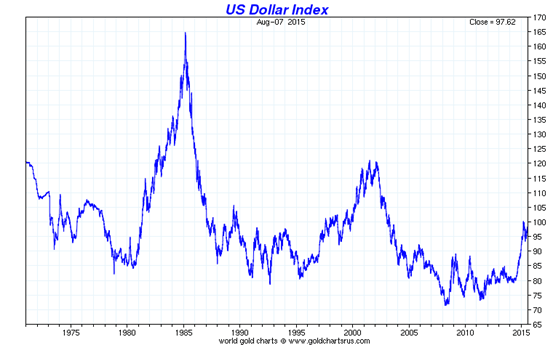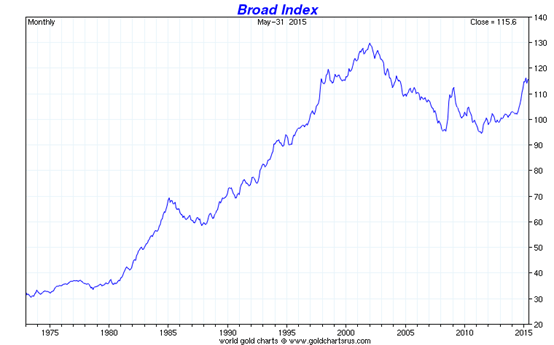Currency wars were all the rage last week.
China’s devaluation of the yuan has put the subject firmly back in the headlines.
With SocGen’s Albert Edwards declaring: “This is the start of something big, something ugly”, today we consider the potential fallout, starting with the Big Daddy – the US dollar.
The big picture suggests the US dollar has further to rise
The US Dollar Index shows the value of the dollar against a basket of foreign currencies. In order of weighting they are: the euro (58%), the yen (14%), the pound (12%), the Canadian dollar (9%), the Swedish krona (4%) and the Swiss franc (4%).
I would say that Asian currencies and commodity currencies (Africa, South America, Australia) are not properly represented, but it’s the benchmark, so we’ll go with it.
Let’s start with the bigger picture. Below is a chart of the US dollar since 1970.
There was a ten-year bear market through the 1970s. Then, from 1980 to 1985, thanks broadly to then-Fed chief Paul Volcker tightening monetary policy, the dollar enjoyed an immense rally.
Another ten years of bear market followed the 1985 peak – the first three years being the most precipitous. We then got another large rally from 1995 to 2001. There followed another ten-year bear market. Again, the first three years were the worst.
You could argue that this most recent bear market ended in 2008, but I’m going to go with the 2011 re-test of the low. That was the peak in commodities and emerging markets.
The lift-off in the dollar bull market only really got going last year, 2014. Based on this pattern of roughly ten-year bear markets and five-year bull markets, I’d say this rally has got at least another two years in it. As a long-term call, 120 seems reasonable as an eventual target.
Of course, it won’t go up in a straight line. And if anything there’s too much consensus around the ‘strong dollar’ story right now, so it’s tempting to take a contrarian stance. (In fact, in my trading account, I’m currently short the dollar against most currencies.)
I’m simply basing that long-term call on previous secular bull markets in the dollar – and a secular bull market is what we appear to be in.
Let’s look now at the dollar against a broader index of currencies, the so-called Broad Index – which includes a wider range of US trading partners including Argentina, Brazil, China, India, and Venezuela among others.
What’s interesting is the relative insignificance of that 1985 high. That’s because many of these currencies are a lot weaker and there have been all sorts of implosions and hyperinflations along the way. Late 2001/early 2002 was the top.
The main takeaway for me is that, while there is some resistance at current levels, there is room for this to go higher too.
Here’s the bottom line: I’m short-term mildly bearish on the dollar, because emerging market currencies, commodity country currencies, the euro – they’re all ‘oversold’.
But in the longer run, the structural problems that are driving these markets lower are yet to be ironed out. Whether it’s the commodities collapse, the political problems in southern Europe, or the implosion of the Chinese stock market, my view is that they all have further to fall. So longer term, the dollar will remain strong.
Who’s laughing now? Not Canadian mining chief execs
The international transfer of wealth to the US over the last few years, thanks to its booming stock and bond markets and the strong dollar, has been breathtaking. I’d love it if some data monkey out there could put a number on it.
I remember going to mining conferences in 2011. Canadian mining CEOs were laughing at how cheap America was. With the commodities boom and the strong Canadian dollar, they were rich, while the housing collapse and the weak US dollar, meant the US was very cheap for them. Many were buying up desres properties next to golf courses at bargain prices.
Hasn’t that changed!
I imagine American tech CEOs are chuckling at how cheap Canadian ski chalets are now (although, despite the fall in the loonie, Canada hasn’t had its long overdue house price crash yet).
If they aren’t already, how long can it be before wealthy Americans start buying up real estate, assets and businesses in southern Europe, South America, Asia or Australia?
The huge economic imbalance between the US and everywhere else could become a major problem. US dollar strength is one of the reasons China has devalued. And it’s unlikely that a 5% fall will be enough to reach its aims. I suspect we’ll see more before this is over.
Meanwhile, a strong US dollar offers its own set of domestic hazards. There’s the importing-exporting conundrum – how long before exporters lose trade to elsewhere? Can the resurgence of US-based manufacturing survive a strong dollar? As John noted last week, the Fed might even end up holding off on its promised interest rate rises – which would present its own set of problems.
At some stage the US will want to devalue too. But not everyone can devalue at once. We must wonder if central banks are working together on this.
What all of this means for the pound
As for us here in the UK, the pound is currently piggy in the middle. It’s not as expensive as the dollar, but its buying power has increased against most other currencies.
This is not such a bad place to be. We’re kind of naturally hedged. The pound is currently trading in a range between $1.54 and $1.58. I maintain my call from the start of the year that we’ll see the other side of $1.60 before the year is out.
• Dominic Frisby is the author of Life After The State and Bitcoin: the Future of Money.
Category: Market updates



